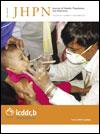Association between Nutritional Status and Positive Childhood Disability Screening Using the Ten Questions Plus Tool in Sarlahi, Nepal
DOI:
https://doi.org/10.3329/jhpn.v28i6.6607Keywords:
Child, Child development, Child nutrition, Cognitive development, Disability, Stunting, NepalAbstract
The study was conducted to examine the association between the indicators of malnutrition and disability of children as reported by caregivers. The Ten Questions Plus questionnaire was administered to caregivers of 1,902 children aged 1-9 years, during August 2007–March 2008, in rural Nepal. Height and weight of chil-dren were also measured. The main outcome was a positive response to one or more questions. In total, 514 (27%) children had a positive response to at least one question. Moderate stunting [odds ratio (OR)=1.47, 95% confidence interval (CI) 1.02-2.12) and severe (OR=2.39, 95% CI 1.60-3.57) stunting were independently associated with reported delay in sitting, standing, or walking. Severe stunting was also associated with report of delayed learning compared to other children of similar age (OR=2.01, 95% CI 1.27-3.20). Parental report of disability was quite prevalent in this setting, with over a quarter of the sample screening positive. Chronic malnutrition may be associated with delayed motor and mental development.Key words: Child; Child development; Child nutrition; Cognitive development; Disability; Stunting; Nepal
DOI: 10.3329/jhpn.v28i6.6607
J HEALTH POPUL NUTR 2010 Dec;28(6):585-594
Downloads
Download data is not yet available.
Abstract
247
247
PDF
236
236
Downloads
How to Cite
Wu, L., Katz, J., Mullany, L., Haytmanek, E., Khatry, S., Darmstadt, G., … Tielsch, J. (2010). Association between Nutritional Status and Positive Childhood Disability Screening Using the Ten Questions Plus Tool in Sarlahi, Nepal. Journal of Health, Population and Nutrition, 28(6), 585–594. https://doi.org/10.3329/jhpn.v28i6.6607
Issue
Section
Original Papers

